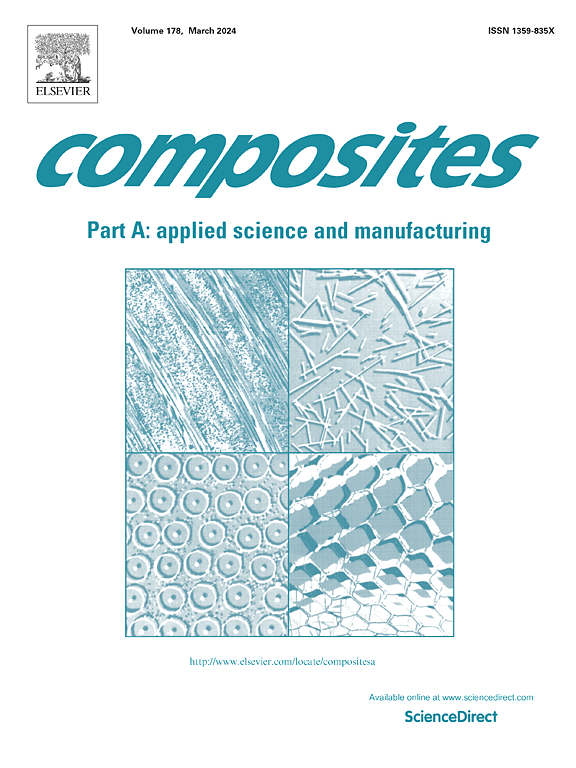不连续天然纤维的施胶:施胶方式和施胶浓度对复合材料性能的影响
IF 8.1
2区 材料科学
Q1 ENGINEERING, MANUFACTURING
Composites Part A: Applied Science and Manufacturing
Pub Date : 2025-05-15
DOI:10.1016/j.compositesa.2025.109029
引用次数: 0
摘要
天然纤维增强复合材料(NFRCs)作为玻璃纤维复合材料的替代品,由于其轻量化和可再生来源,在汽车应用中越来越受到关注。然而,天然纤维固有的亲水性导致与疏水聚合物的相容性差,这对复合材料的机械性能产生不利影响,并限制了其在非结构部件上的应用。施胶是合成纤维改善纤维与基体界面的常用方法。然而,对天然纤维施胶的研究有限,因此是这项工作的重点。在本研究中,研究了两种不同的上浆方法,即:;(1)原位施胶;(2)原位施胶。采用商用聚丙烯(PP)为基础的施胶剂,研究了不同施胶溶液浓度(1.5、2.5和3.5 wt%)对复合材料性能的影响。结果表明,原位施胶制备的复合材料与原位施胶制备的复合材料相比,具有更好的纤维-基体粘附性和拉伸性能。在研究不同施胶浓度对复合材料性能的影响时,我们发现,当施胶浓度达到2.5 wt%(溶液)时,复合材料的抗拉强度增加(约42%),然后下降。然而,当浆料含量超过1.5 wt%(约40%)时,冲击强度显著下降。此外,该研究还进一步扩展了上浆对不同NFRCs(椰胶、香蕉纤维和棉麻纤维)的影响,发现上浆的效果受到纤维表面形态的影响。本文章由计算机程序翻译,如有差异,请以英文原文为准。
Sizing of discontinuous natural fibers: Effect of sizing approach and sizing concentration on composite properties
Natural fiber reinforced composites (NFRCs) are gaining attention in automotive applications as an alternative to glass fiber composites due to their lightweight and renewable sourcing. However, the inherent hydrophilicity of natural fibers leads to poor compatibility with hydrophobic polymers which adversely affects the mechanical properties of the composites and can limit their application to non-structural parts. Sizing is a common approach used for synthetic fibers to improve the interface between fiber and matrix. However, there is limited study on the sizing of natural fibers, and hence the focus of this work. In this study, two different approaches to sizing discontinuous coir fibers were investigated, namely; (1) ex-situ sizing and (2) in-situ sizing. A commercial polypropylene (PP) based sizing agent was used and the effects of varying sizing solution concentrations (1.5, 2.5, and 3.5 wt%) on the properties of the composites was studied. Results showed that composites prepared via the in-situ sizing process had better fiber–matrix adhesion and improved tensile properties compared to ex-situ sized composites. On studying the effect of different sizing concentrations on composite properties, we found that the tensile strength of the composites increased (by ∼ 42 %) up to 2.5 wt% sizing concentration (in solution) and then decreased. However, the impact strength decreased significantly on increasing the sizing content beyond 1.5 wt% (by ∼ 40 %). Additionally, the study was further extended to investigate the effect of sizing on different NFRCs (coir, banana, and cottonized hemp fiber) where effectiveness of sizing was found to be influenced by the fiber surface morphology.
求助全文
通过发布文献求助,成功后即可免费获取论文全文。
去求助
来源期刊

Composites Part A: Applied Science and Manufacturing
工程技术-材料科学:复合
CiteScore
15.20
自引率
5.70%
发文量
492
审稿时长
30 days
期刊介绍:
Composites Part A: Applied Science and Manufacturing is a comprehensive journal that publishes original research papers, review articles, case studies, short communications, and letters covering various aspects of composite materials science and technology. This includes fibrous and particulate reinforcements in polymeric, metallic, and ceramic matrices, as well as 'natural' composites like wood and biological materials. The journal addresses topics such as properties, design, and manufacture of reinforcing fibers and particles, novel architectures and concepts, multifunctional composites, advancements in fabrication and processing, manufacturing science, process modeling, experimental mechanics, microstructural characterization, interfaces, prediction and measurement of mechanical, physical, and chemical behavior, and performance in service. Additionally, articles on economic and commercial aspects, design, and case studies are welcomed. All submissions undergo rigorous peer review to ensure they contribute significantly and innovatively, maintaining high standards for content and presentation. The editorial team aims to expedite the review process for prompt publication.
 求助内容:
求助内容: 应助结果提醒方式:
应助结果提醒方式:


